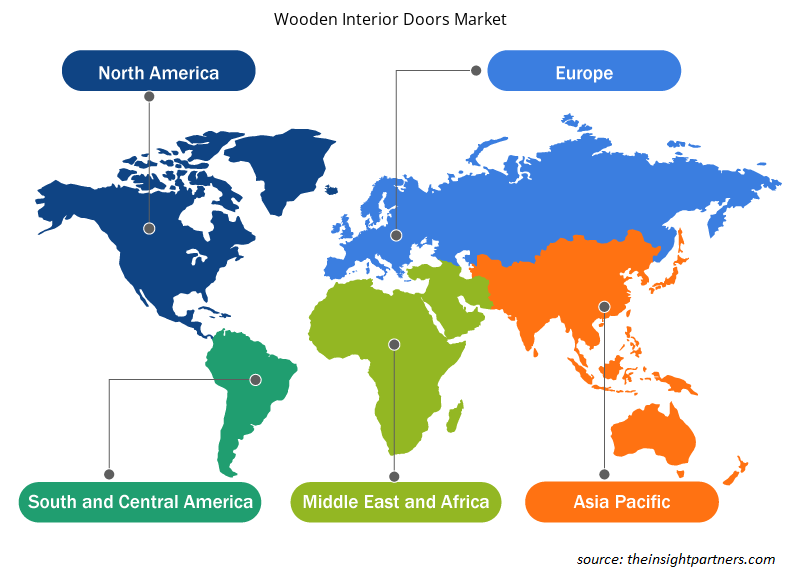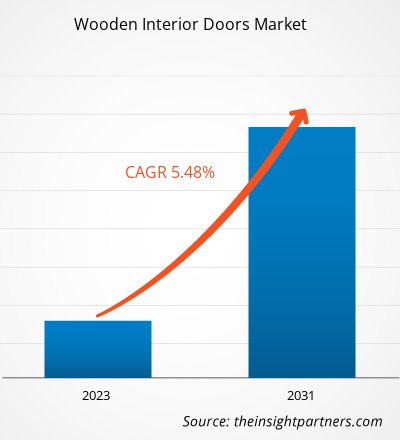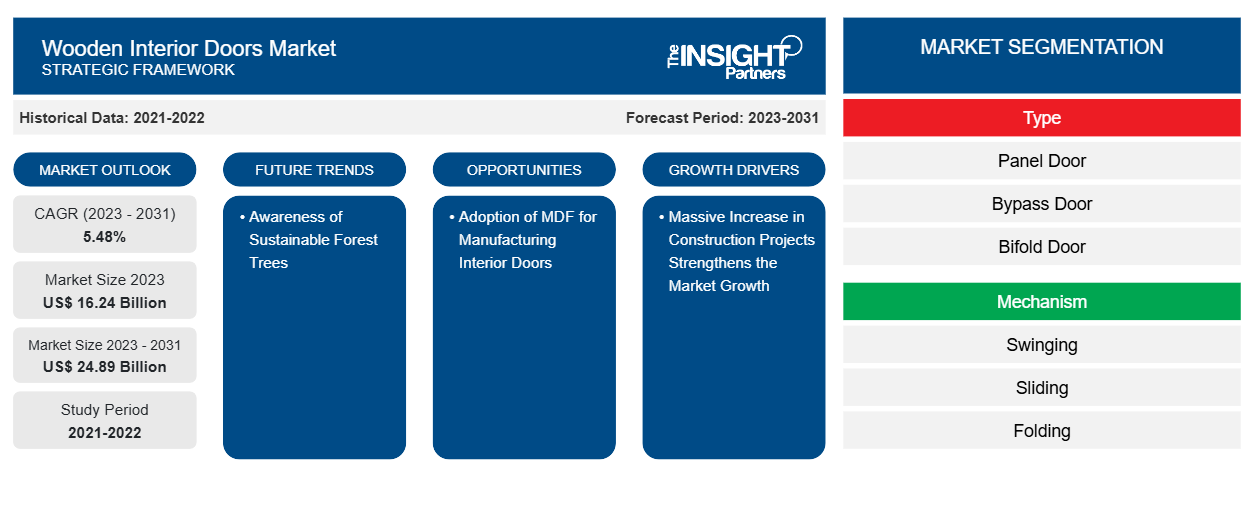من المتوقع أن يصل حجم سوق الأبواب الداخلية الخشبية إلى 24.89 مليار دولار أمريكي بحلول عام 2031 من 16.24 مليار دولار أمريكي في عام 2023. ومن المتوقع أن يسجل السوق معدل نمو سنوي مركب بنسبة 5.48٪ في الفترة 2023-2031. وفقًا لتقرير البناء العالمي 2030، من المتوقع أن يزيد حجم الناتج الإنشائي بنسبة 85٪ إلى 15.5 تريليون دولار أمريكي بحلول عام 2030 في جميع أنحاء العالم. ومن المتوقع أن تقود الولايات المتحدة والصين والهند المسار وتمثل أكثر من نصف حصة النمو العالمي. علاوة على ذلك، فإن الاستثمار في تجديد المباني والهياكل القديمة والميل المتزايد نحو مستقبل أكثر خضرة يعزز نطاق المباني الخضراء، مما يعزز قطاع البناء بشكل أكبر.
تحليل سوق الأبواب الداخلية الخشبية
في عصر التحضر المتزايد، يزدهر قطاع البناء بمعدل هائل. ومع ارتفاع مشاريع البناء، يزدهر أيضًا الطلب على المكونات ذات الصلة، بما في ذلك منتجات المفروشات مثل الأبواب الداخلية. لذلك، لمواكبة وتيرة التحضر المتزايد دون ترك أي تأثير ضار على البيئة، يتم تنفيذ الغابات المستدامة. تركز الغابات المستدامة على إنقاذ الغابات الطبيعية من خلال تنفيذ عمليات التشجير وإعادة التشجير، فضلاً عن استخدام تقنيات قطع الأشجار ذات التأثير المنخفض.
نظرة عامة على سوق الأبواب الداخلية الخشبية
وقد تم تقدير أن الإسكان سيستمر، وبالتالي فإن إيجاد حل مناسب أمر لا بد منه لتلبية طلب السكان الحضريين. ومن المتوقع أن يحتاج 3 مليارات شخص (ما يقرب من 40٪ من سكان العالم) إلى مرافق سكنية جديدة بحلول عام 2030، وهو ما يترجم إلى طلب ما يقرب من 300 مليون مسكن جديد. وبالتالي، فإن الطلب المتزايد المذكور أعلاه على الإسكان، إلى جانب الحاجة إلى بيئة آمنة، يدفع مفهوم الغابات المستدامة . سيكون لهذا الجانب تأثير إيجابي على نمو سوق الأبواب الداخلية الخشبية.
قم بتخصيص هذا التقرير ليناسب متطلباتك
ستحصل على تخصيص لأي تقرير - مجانًا - بما في ذلك أجزاء من هذا التقرير، أو تحليل على مستوى الدولة، وحزمة بيانات Excel، بالإضافة إلى الاستفادة من العروض والخصومات الرائعة للشركات الناشئة والجامعات
- احصل على أهم اتجاهات السوق الرئيسية لهذا التقرير.ستتضمن هذه العينة المجانية تحليلاً للبيانات، بدءًا من اتجاهات السوق وحتى التقديرات والتوقعات.
محركات وفرص سوق الأبواب الداخلية الخشبية
الزيادة الهائلة في مشاريع البناء تعزز نمو السوق
مع تزايد عدد السكان الحضريين، زادت الحاجة إلى المباني الشاهقة بشكل كبير في المناطق الحضرية. وفقًا لمجلس المباني الشاهقة والمساكن الحضرية (CTBUH)، تم بناء 1480 ناطحة سحاب بارتفاع يزيد عن 200 متر في العقدين الماضيين في الولايات المتحدة. ويشمل الرقم أيضًا 40 ناطحة سحاب سكنية تم بناؤها في السنوات الأخيرة الماضية. إن الزيادة في أعمال البناء في جميع الصناعات السكنية والتجارية والعديد من الصناعات بسبب التوسع الحضري المتزايد يدفع نمو الأبواب الداخلية. تركز الهيئات الحكومية بشكل إضافي على تعزيز البناء وتطوير البنية التحتية، مما يزيد من الطلب على الأبواب الداخلية.
استخدام MDF في تصنيع الأبواب الداخلية
MDF هو منتج خشبي مصمم بشكل عام مصنوع من ألياف الخشب المعاد تدويرها. أصبح MDF أكثر مواد الأبواب الداخلية استخدامًا نظرًا لمتانته وبأسعار معقولة. علاوة على ذلك، فإن الأبواب الداخلية المصنوعة من MDF أكثر كثافة من الخشب الرقائقي واللوح الجسيمي، وهو عامل آخر يجذب كل من المنازل والتجار. بصرف النظر عن الميزات المذكورة أعلاه، فإن الحواف الناعمة للغاية وعدم وجود متطلبات للصفائح تجعل MDF مختلفًا عن الألواح الجسيمية والمواد الخشبية الأخرى. لذلك، تشهد شعبية MDF اتجاهًا تصاعديًا، ومن المتوقع أن يوفر فرص عمل مربحة لمصنعي الأبواب الداخلية الخشبية.
تقرير تحليلي لتجزئة سوق الأبواب الداخلية الخشبية
إن القطاعات الرئيسية التي ساهمت في اشتقاق تحليل سوق الأبواب الداخلية الخشبية هي النوع والآلية والمستخدم النهائي.
- وفقًا للطريقة، يتم تقسيم السوق إلى أبواب الألواح، وأبواب الالتفاف ، والأبواب القابلة للطي، والأبواب الجيبية وغيرها. احتلت شريحة الأبواب اللوحية حصة سوقية أكبر في عام 2023.
- بناءً على الآلية، ينقسم سوق الأبواب الداخلية الخشبية العالمية إلى أبواب متأرجحة وأبواب منزلقة وأبواب قابلة للطي وغيرها. احتلت الأبواب المتأرجحة حصة سوقية أكبر في عام 2023.
- اعتمادًا على المستخدم النهائي، ينقسم السوق العالمي إلى سكني وغير سكني. احتل القطاع السكني حصة سوقية أكبر في عام 2023.
تحليل حصة سوق الأبواب الداخلية الخشبية حسب المنطقة الجغرافية
يغطي نطاق تقرير سوق الأبواب الداخلية الخشبية أمريكا الشمالية (الولايات المتحدة وكندا والمكسيك) وأوروبا (إسبانيا والمملكة المتحدة وألمانيا وفرنسا وإيطاليا وبقية أوروبا) وآسيا والمحيط الهادئ (كوريا الجنوبية والصين والهند واليابان وأستراليا وبقية آسيا والمحيط الهادئ) والشرق الأوسط وأفريقيا (جنوب إفريقيا والمملكة العربية السعودية والإمارات العربية المتحدة وبقية الشرق الأوسط وأفريقيا) وأمريكا الجنوبية والوسطى (البرازيل والأرجنتين وبقية أمريكا الجنوبية والوسطى). من حيث الإيرادات، سيطرت منطقة آسيا والمحيط الهادئ على حصة سوق الأبواب الداخلية الخشبية في عام 2023. تعد أوروبا ثاني أكبر مساهم في سوق الأبواب الداخلية الخشبية العالمية، تليها أمريكا الشمالية. في المشهد العالمي للسوق، كانت الصين من بين أكبر مستهلكي MDF في عام 2022، حيث استحوذت على أكثر من 50٪ من إجمالي حجم السوق. بالإضافة إلى ذلك، تجاوزت الصين الولايات المتحدة من حيث استهلاك MDF. تعد بيلاروسيا وتركيا وبولندا أسواقًا بارزة أخرى معروفة بأعلى مستويات استهلاك MDF للفرد. ومن المتوقع أن يؤدي هذا الاتجاه المرتفع في الاستهلاك في هذه البلدان إلى دفع نطاق استخدام ألواح الألياف متوسطة الكثافة في تصنيع المفروشات المنزلية بما في ذلك الأبواب الداخلية.
نظرة إقليمية على سوق الأبواب الداخلية الخشبية
لقد قام المحللون في Insight Partners بشرح الاتجاهات والعوامل الإقليمية المؤثرة على سوق الأبواب الداخلية الخشبية طوال فترة التوقعات بشكل شامل. يناقش هذا القسم أيضًا قطاعات سوق الأبواب الداخلية الخشبية والجغرافيا في جميع أنحاء أمريكا الشمالية وأوروبا ومنطقة آسيا والمحيط الهادئ والشرق الأوسط وأفريقيا وأمريكا الجنوبية والوسطى.

- احصل على البيانات الإقليمية المحددة لسوق الأبواب الداخلية الخشبية
نطاق تقرير سوق الأبواب الداخلية الخشبية
| سمة التقرير | تفاصيل |
|---|---|
| حجم السوق في عام 2023 | 16.24 مليار دولار أمريكي |
| حجم السوق بحلول عام 2031 | 24.89 مليار دولار أمريكي |
| معدل النمو السنوي المركب العالمي (2023 - 2031) | 5.48% |
| البيانات التاريخية | 2021-2022 |
| فترة التنبؤ | 2023-2031 |
| القطاعات المغطاة | حسب النوع
|
| المناطق والدول المغطاة | أمريكا الشمالية
|
| قادة السوق وملفات تعريف الشركات الرئيسية |
|
كثافة اللاعبين في سوق الأبواب الداخلية الخشبية: فهم تأثيرها على ديناميكيات الأعمال
يشهد سوق الأبواب الداخلية الخشبية نموًا سريعًا، مدفوعًا بالطلب المتزايد من المستخدم النهائي بسبب عوامل مثل تفضيلات المستهلك المتطورة والتقدم التكنولوجي والوعي المتزايد بفوائد المنتج. ومع ارتفاع الطلب، تعمل الشركات على توسيع عروضها والابتكار لتلبية احتياجات المستهلكين والاستفادة من الاتجاهات الناشئة، مما يؤدي إلى زيادة نمو السوق.
تشير كثافة اللاعبين في السوق إلى توزيع الشركات أو المؤسسات العاملة في سوق أو صناعة معينة. وهي تشير إلى عدد المنافسين (اللاعبين في السوق) الموجودين في مساحة سوق معينة نسبة إلى حجمها أو قيمتها السوقية الإجمالية.
الشركات الرئيسية العاملة في سوق الأبواب الداخلية الخشبية هي:
- مفهوم SGA Inc
- شركة سيمبسون للأبواب
- شركة جيلد وين القابضة
- شركة مارفن المحدودة
- شركة ماسونيت الدولية
- وودجرين المحدودة
إخلاء المسؤولية : الشركات المذكورة أعلاه ليست مرتبة بأي ترتيب معين.

- احصل على نظرة عامة على أهم اللاعبين الرئيسيين في سوق الأبواب الداخلية الخشبية
أخبار سوق الأبواب الداخلية الخشبية والتطورات الأخيرة
يتم تقييم سوق الأبواب الداخلية الخشبية من خلال جمع البيانات النوعية والكمية بعد البحث الأولي والثانوي، والتي تتضمن منشورات الشركات المهمة وبيانات الجمعيات وقواعد البيانات. فيما يلي قائمة بالتطورات في سوق الأبواب الداخلية الخشبية والاستراتيجيات:
- في فبراير 2022، قامت شركة Simpson Redi-Prime، إحدى العلامات التجارية الأكثر شهرة للأبواب الداخلية المطلية المصنوعة بشكل استثنائي ، بتوسيع خط منتجاتها ليشمل أبواب الزوايا المقصوصة للمساحات الفريدة داخل المنزل. مع استمرار العديد من الشركات في إجراء عمليات التجديد لاستيعاب الوظائف المتطورة باستمرار للمنزل، يتم شحن الزاوية العلوية لباب الزوايا المقصوص Redi-Prime مقطوعة مسبقًا بزاوية لتناسب مخصص. والنتيجة هي حل تصميم مخصص لأي تطبيق لا يمكنه استيعاب باب داخلي قياسي بقمة مربعة. (المصدر: شركة Simpson Door Company، بيان صحفي/موقع الشركة على الويب/النشرة الإخبارية)
تقرير سوق الأبواب الداخلية الخشبية: التغطية والنتائج المتوقعة
يوفر تقرير "حجم سوق الأبواب الداخلية الخشبية والتوقعات (2021-2031)" تحليلاً مفصلاً للسوق يغطي المجالات التالية:
- حجم السوق والتوقعات على المستويات العالمية والإقليمية والوطنية لجميع قطاعات السوق الرئيسية التي يغطيها النطاق
- ديناميكيات السوق مثل المحركات والقيود والفرص الرئيسية
- الاتجاهات المستقبلية الرئيسية
- تحليل مفصل لقوى بورتر الخمس
- تحليل السوق العالمي والإقليمي الذي يغطي اتجاهات السوق الرئيسية واللاعبين الرئيسيين واللوائح والتطورات الأخيرة في السوق
- تحليل المشهد الصناعي والمنافسة الذي يغطي تركيز السوق، وتحليل خريطة الحرارة، واللاعبين البارزين، والتطورات الأخيرة
- ملفات تعريف تفصيلية للشركة مع تحليل SWOT
- التحليل التاريخي (سنتان)، سنة الأساس، التوقعات (7 سنوات) مع معدل النمو السنوي المركب
- تحليل PEST و SWOT
- حجم السوق والقيمة / الحجم - عالمي، إقليمي، بلد
- الصناعة والمنافسة
- مجموعة بيانات إكسل
التقارير الحديثة
تقارير ذات صلة
شهادات العملاء
سبب الشراء
- اتخاذ قرارات مدروسة
- فهم ديناميكيات السوق
- تحليل المنافسة
- رؤى العملاء
- توقعات السوق
- تخفيف المخاطر
- التخطيط الاستراتيجي
- مبررات الاستثمار
- تحديد الأسواق الناشئة
- تحسين استراتيجيات التسويق
- تعزيز الكفاءة التشغيلية
- مواكبة التوجهات التنظيمية





















 احصل على عينة مجانية ل - سوق الأبواب الداخلية الخشبية
احصل على عينة مجانية ل - سوق الأبواب الداخلية الخشبية